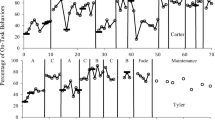Abstract
Numerous previous studies have shown that one-zero sampling in direct observation systematically overestimates behavioral durations. Apost hoc correction procedure has been proposed and demonstrated to be capable of removing most of the systematic errors found in one-zero duration estimates. However, the remaining errors for some individual observation sessions can still be quite substantial in practical terms. In this paper, the condition under which thepost hoc correction procedure will produce results with negligible systematic errors in one-zero duration estimates is identified.
Similar content being viewed by others
References
Altmann, J., 1974. Observational study of behavior: Sampling methods.Behaviour, 49: 227–267.
Ary, D., 1984. Mathematical prediction of sampling component of behavior observation measurement error.Behav. Assess., 6: 221–228.
————, &H. K. Suen, 1983. The use of momentary time sampling to assess both frequency and duration of behavior.J. Behav. Assess., 5: 143–150.
Brulle, A. R. &A. C. Repp, 1984. An investigation of the accuracy of momentary time sampling procedures with time series data.Brit. J. Psychol., 75: 481–485.
Dunbar, R., 1976. Some aspects of research design and their implications in the observational study of behavior.Behaviour, 58: 79–98.
Goodenough, F. L., 1928. Measuring behavior traits by means of repeated short samples.J. Juv. Res., 12: 230–235.
Green, S. B. &L. G. Alverson, 1978. A comparison of indirect measures of long-duration behaviors.J. Appl. Behav. Analys., 11: 530.
Griffin, B. &R. Adams, 1983. A parametric model for estimating prevalence, incidence, and mean bout duration from point sampling.Amer. J. Primatol., 4: 261–271.
Kraemer, H. C., 1979. One-zero sampling in the study of primate behavior.Primates, 20: 237–244.
Legar, D., 1977. An empirical evaluation of instantaneous and one-zero sampling of chimpanzee behavior.Primates, 18: 387–393.
McDowell, E., 1973. Comparison of time-sampling and continuous recording techniques for observing developmental change in caretaker and infant behaviors.J. Genet. Psychol., 123: 99–105.
Milar, C. &R. Hawkins, 1976. Distorted results from the use of interval recording techniques. In:Behaviour Analysis in Education: Self-control and Reading,T. Bringham,J. Scott, &T. Laughling (eds.), Kendall/Hunt, Dubuque, Iowa, pp. 261–273.
Murphy, G. &E. Goodall, 1980. Measurement error in direct observations: A comparison of common recording methods.Behav. Res. Therapy, 18: 147–150.
Powell, J., A. Martindale, &S. Kulp, 1975. An evaluation of time-sample measure of behavior.J. Appl. Behav. Analys., 8: 463–469.
————,D. Martindale, S. Kulp, A. Martindale, &R. Bauman, 1977. Taking a closer look: Time sampling and measurement error.J. Appl. Behav. Analys., 10: 325–332.
————, &R. Rockinson, 1978. On the inability of interval time sampling to reflect frequency of occurrence data.J. Appl. Behav. Analys., 11: 531–532.
Rhine, R. J. &M. Flanigon, 1978. An empirical comparison of one-zero, focal-animal, and instantaneous methods of sampling spontaneous primate social behavior.Primates, 19: 353–361.
———— &A. K. Linville, 1980. Properties of one-zero scores in observational studies of primate social behavior: The effect of assumptions on empirical analyses.Primates, 21: 111–122.
Sanson-Fisher, R., A. Poole, &J. Dunn, 1980. An empirical method for determining an appropriate interval length for recording behavior.J. Appl. Behav. Analys., 13: 493–500.
Simpson, M. J. A. &A. E. Simpson, 1977. One-zero and scan-methods for sampling behavior.Anim. Behav., 25: 726–731.
Suen, H. K. &D. Ary, 1984. Variables influencing one-zero and instantaneous time sampling outcomes.Primates, 25: 89–94.
———— & ————, 1986a. Poisson cumulative probabilities of systematic errors in single-subject and multiple-subject time sampling.Behav. Assess., 8: 155–169.
———— & ————, 1986b. Apost hoc correction procedure for systematic errors in time sampling duration estimates.J. Psychopathol. Behav. Assess., 8(1): 31–38.
Author information
Authors and Affiliations
About this article
Cite this article
Suen, H.K. On the utility of aPost Hoc correction procedure for one-zero sampling duration estimates. Primates 27, 237–244 (1986). https://doi.org/10.1007/BF02382602
Received:
Accepted:
Issue Date:
DOI: https://doi.org/10.1007/BF02382602




